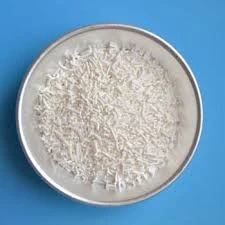
emulsifier e476
Understanding E476 The Multifunctional Emulsifier
In the realm of food additives, E476, also known as Polyglycerol Esters of Fatty Acids, stands out as a versatile emulsifier widely used in various food products. This compound is recognized for its ability to stabilize mixtures of oil and water, thus playing a crucial role in the texture and consistency of many food items. As consumers increasingly scrutinize food labels and ingredients, understanding E476's characteristics, uses, and safety profiles becomes essential.
What is E476?
E476 is derived from natural glycerol and fatty acids, typically sourced from vegetable oils. The process involves the esterification of glycerol with fatty acids, resulting in a complex mixture that can vary in its composition. This variability enables manufacturers to tailor E476 for specific applications in food production, making it a highly favored ingredient in the industry.
Functions of E476 in Food Products
1. Emulsification The primary function of E476 is to act as an emulsifier. Emulsifiers help stabilize emulsions—mixtures of oil and water that would otherwise separate. By reducing the surface tension between the two phases, E476 helps maintain a uniform consistency in products like salad dressings, sauces, and ice creams.
2. Texture Improvement E476 contributes to the mouthfeel and texture of food products. Its ability to form a stable emulsion allows for the smoothness in creamy products, enhancing the overall sensory experience for consumers.
3. Moisture Retention In baked goods, E476 helps retain moisture, prolonging shelf life and improving the freshness of items like cakes, muffins, and bread. This moisture retention is crucial in preventing staleness and ensuring that baked products remain appealing for longer periods.
4. Stabilization of Foams Apart from emulsifications, E476 also aids in stabilizing foams. This is particularly important in products like whipped toppings and mousses, where a light, airy texture is desired.
emulsifier e476

Common Uses of E476
E476 is commonly found in a myriad of processed foods. Its applications span across
- Dairy Products Ice creams, yogurt, and cheese spread often contain E476 to enhance creaminess and prevent separation. - Baked Goods Many commercial cakes, cookies, and breads utilize this emulsifier to improve texture and moisture content. - Sauces and Dressings E476 is a staple ingredient in salad dressings and sauces, providing stability and preventing oil separation. - Confectionery Candies, chocolates, and other sweet treats may include E476 to ensure a smooth texture and consistent quality.
Safety and Regulations
The safety of E476 has been evaluated by various food safety authorities, including the European Food Safety Authority (EFSA) and the U.S. Food and Drug Administration (FDA). Both agencies consider E476 safe for consumption within the established limits. Nonetheless, as with any food additive, excessive intake should be avoided, and consumers are encouraged to maintain a balanced diet.
As with many emulsifiers, there is ongoing research examining the implications of their consumption on health. While E476 is deemed safe, some individuals may have sensitivities to certain emulsifiers and should be cautious when consuming products containing it.
Conclusion
E476, or Polyglycerol Esters of Fatty Acids, is an essential emulsifier that enhances the quality, texture, and shelf life of many food products. Its multifunctional capabilities make it a go-to ingredient for manufacturers aiming to create appealing and stable food products. As consumers become more informed about food ingredients, understanding the roles and safety of additives like E476 will empower them to make better dietary choices. Whether in ice cream, baked goods, or dressings, E476 plays a crucial role in the culinary landscape, contributing significantly to the food industry's ongoing evolution.
-
Why Glacial Acetic Acid Food Grade Is Essential in FlavorNewsMay.26,2025
-
Surging Export Growth of Food Additives in ChinaNewsMay.26,2025
-
How Ammonium Nitrate Fertilizer Boosts Crop YieldsNewsMay.26,2025
-
How 1,2,3-Benzotriazole Shields Plastics from UV DegradationNewsMay.26,2025
-
Cyanide in Gold Mining: Protecting People and the PlanetNewsMay.26,2025
-
Aluminum Hydroxide in Modern Sunscreen FormulationsNewsMay.26,2025
-
Understanding Synthetic Rubber OptionsNewsApr.27,2025
Hebei Tenger Chemical Technology Co., Ltd. focuses on the chemical industry and is committed to the export service of chemical raw materials.
-

view more DiethanolisopropanolamineIn the ever-growing field of chemical solutions, diethanolisopropanolamine (DEIPA) stands out as a versatile and important compound. Due to its unique chemical structure and properties, DEIPA is of interest to various industries including construction, personal care, and agriculture. -

view more TriisopropanolamineTriisopropanolamine (TIPA) alkanol amine substance, is a kind of alcohol amine compound with amino and alcohol hydroxyl, and because of its molecules contains both amino and hydroxyl. -

view more Tetramethyl Thiuram DisulfideTetramethyl thiuram disulfide, also known as TMTD, is a white to light-yellow powder with a distinct sulfur-like odor. It is soluble in organic solvents such as benzene, acetone, and ethyl acetate, making it highly versatile for use in different formulations. TMTD is known for its excellent vulcanization acceleration properties, which makes it a key ingredient in the production of rubber products. Additionally, it acts as an effective fungicide and bactericide, making it valuable in agricultural applications. Its high purity and stability ensure consistent performance, making it a preferred choice for manufacturers across various industries.











